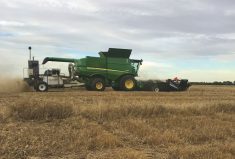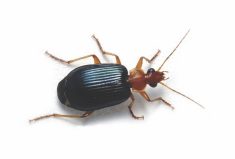Waterhemp has spread further across Ontario during the 2019 season and can now be found in eight counties (Bruce, Chatham-Kent, Essex, Haldimand, Lambton, Middlesex, Norfolk and Northumberland).
A close relative of pigweed, waterhemp is a competitive annual broadleaf weed that has been found resistant in the province to four different herbicide groups (Group 9: Roundup, Group 2: Classic, Group 5: Atrazine/Sencor and Group 14: Reflex). This makes management a challenge, particularly in soybeans.
Unfortunately, for many farmers who have found waterhemp on their farm, by the time plants are large enough for easier identification, they are past a reasonable stage for control with herbicides. In some instances, the waterhemp population is so abundant, the best option is destroy the crop to prevent the production of more seed (Figure 1 at top).
In corn and soybeans, the use of pre-emergence herbicides is critical for the management of waterhemp. Because the removal of early-season weed competition in corn and soybeans is so important for yield maximization, it will be money well spent even if you don’t have waterhemp on your farm. The pre-emergence herbicides that are effective on waterhemp are also effective on a number of competitive annual weeds.

Fortunately, the University of Guelph (Ridgetown Campus) has been evaluating various options in corn, soybean and cereals. Here is a rundown of herbicides that have been found to provide better than 80 per cent control of waterhemp.
Corn (Pre-emergence herbicides)
- Greater than 90 per cent control: Acuron, Lumax EZ.
- Between 80 to 85 per cent: Integrity, Converge XT, Callisto + Aatrex 480.
Soybean (Pre-emergence herbicides)
- Greater than 90 per cent control: Fierce.
- Between 85 to 89 per cent: Authority Supreme, Boundary LQD, TriActor, Sencor, Valtera.
- Between 80 to 85 per cent: Dual II Magnum.
Wheat (Post-emergence herbicides)
- Greater than 90 per cent control: Lontrel, Pixxaro, Infinity, Infinity FX and 2,4-D Ester.
- Between 80 to 85 per cent control: Trophy, Estaptrop.
Read Also

Agronomists share tips for evaluating new crop products and tech: Pt. 3
With new products, new production practices and new technology converging on the agriculture industry at a frenetic pace in recent…
Cover crops
- Fall-seeded cereal rye has been observed to reduce waterhemp biomass.
Have a question you want answered? Hashtag #PestPatrol on Twitter to @cowbrough or email Mike at [email protected].















